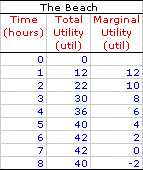
|
|
BANK PANIC OF 1907: A relatively serious economic downturn, that is business-cycle contraction, in 1907 that was caused by serious, big-time, instability in the banking system. This major bank panic was so severe (the term depression is more applicable than recession) that it prompted Congress to establish the Federal Reserve System, which came into existence in 1913. See fractional-reserve banking.
Visit the GLOSS*arama
|
|


|

|
|
Lesson 10: Utility and Demand | Unit 4: On To Demand
|
Page: 14 of 21
|
|
Topic:
A Generalized Choice
|
|
|

|
- In many cases buyers are making choices between ONE good and EVERY other good that they could be purchasing.
- The presumption is that every other good satisfies the rule of consumer equilibrium.
- The question now becomes: How much beach frolicking do I undertake (or purchase) given that my going marginal utility-price ratio is 3 utils per dollar for other goods?
- Employing the rule of consumer equilibrium, I need to equate the marginal utility-price ratio (MU/P) for beach frolicking with the marginal utility-price ratio for other goods.
MU/P for beach frolicking = MU/P for other goods - Because the marginal utility-price ratio for other goods is 2 utils per dollar, the time I spend at the beach needs generates to generate the same 2 utils per dollar.
- If the price per hour at the beach is $2, then I need to stay at the beach until my marginal is 4 utils, a value generated at 5 hours. This gives me a marginal utility-price ratio (MU/P) for beach activity of 2 utils per dollar.
- I have satisfied the rule of consumer equilibrium!
|
|
|
|
|

|
|
PROFIT MAXIMIZATION The process of obtaining the highest possible level of profit through the production and sale of goods and services. The profit-maximization assumption is the guiding principle underlying production by a firm. In particular, it is assumed that firms undertake actions and make the decisions that increase profit. The profit-maximization assumption is the production counterpart to the utility-maximization assumption for consumer behavior.
Complete Entry | Visit the WEB*pedia |



|

|
BLUE PLACIDOLA
[What's This?]
Today, you are likely to spend a great deal of time flipping through the yellow pages seeking to buy either a coffee cup commemorating the first day of spring or a printer that works with your stockpile of ink cartridges. Be on the lookout for the happiest person in the room.
Your Complete Scope
This isn't me! What am I?
|

|
|
Three-forths of the gold mined each year is used to manufacture jewelry.
|

|
|
"Old age isn't so bad when you consider the alternative. " -- Cato, Roman orator
|

|
NORC
National Opinion Research Center
|

|
|
Tell us what you think about AmosWEB. Like what you see? Have suggestions for improvements? Let us know. Click the User Feedback link.
User Feedback
|


|


